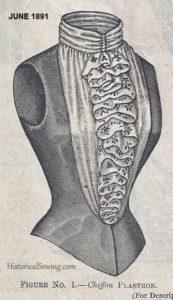
“Plastron” – say what?? It sounds so formal. Or rather gladiator. I mean, it’s traditionally the chest and sleeve pad worn by fencers. So how do they connect into Victorian fashion?
(Hint: they aren’t chemisettes but are related in being Victorian accessories.)
As with all things Late Victorian with feminine frou-frou and gorgeousness, you’ll come to drool over the possibilities of what a plastron accessory can do for your costume. It can kick up your ensemble a good notch or two!
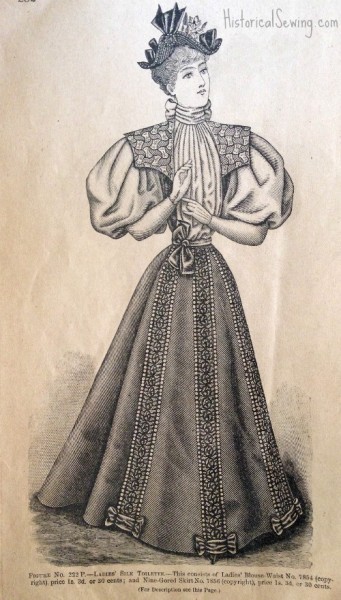
Usually when one thinks of the last decade of the 19th century, visions of huge puffy sleeves and full skirts come to mind. Yummy!
Detailed embroidery and carefully placed trim is everywhere. Even though layers of petticoats, Gibson Girl hair, tightly-cinched waists and fine tailoring abound, they are enhanced with the proper accessories.

If you look through the various fashion publications and magazines of the time you’ll notice a wide variety of collars, fichus (yes, that term was still used in the mid-1890s), plastrons, epaulettes, jabots and ruffs decorate the most basic of bodices and turn them into exciting “new” garments to wear again.
(Isn’t it fun to revamp the historical wardrobe?)
These indispensable additions conceal worn out areas and keep your wardrobe looking fresh and sophisticated.
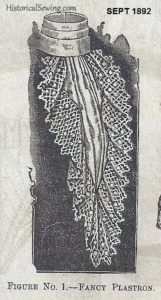
The “Stylish Lingerie” section from the September 1892 Delineator describes these fancy articles perfectly. (Although in our modern reading of it, these accessories seem strange to be under the “lingerie” heading, but just go with it for now.)
“Novel and striking accessories for simply fashioned toilettes of dark fabrics that require their brightening influence are the cuffs, collar and girdle [wide belt] wrought elaborately with bright, shining gold embroideries. Pretty, dainty fronts and neck garnitures are always favored, since they serve such a number of purposes. To a partly worn gown or one that is slightly passé in style, a fluffy, fancy front of lace or some diaphanous fabric is a positive boon.”
So take heart if you view your costume as plain. Do what our ancestors did and add some “shiny” or “bling!” A remnant of lace or embroidered chiffon will do well for a quick bodice accessory.

In simple fashion terms, a plastron covers the chest. You could also think of it as a false front and resembles a jabot.
In the 1890s most plastrons were made of a stiff cotton lining, possibly boned, attached to a collar piece and decorated with frilly lace along the sides. It was wide at the neckline and shoulders and most often tapered to a point or narrow width at the waist.
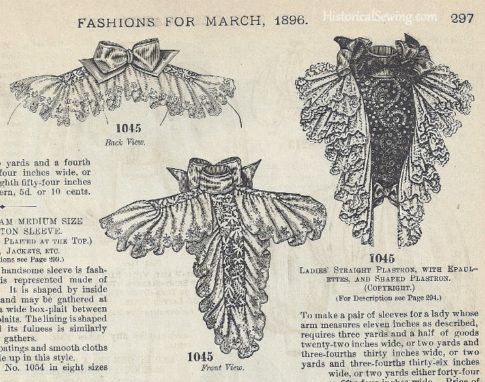
Epaulettes (shoulder bars) were sometimes attached to the plastron to fall over the shoulders and around the back neckline – to beautiful effect!
The epaulette extended to the armhole seam where the lace or ruffle sewn to the epaulette fell over the top of the full puffed sleeve. (Gotta make those shoulders as wide as possible so your waist looks as tiny as that girl in the corset ad!)
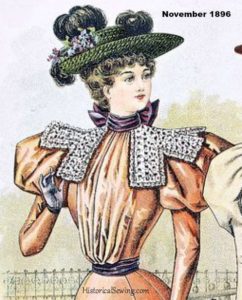
How to Attach the Plastron to a Bodice
Make up the bodice with the right-hand side of the plastron enclosed in the right-hand side front princess seam, finishing that half of the bodice. Close up the center front of the bodice with hook & eye sets. Finish the plastron left side edges.
When wearing, fasten up the center front of the bodice; Fold the plastron over the bodice front (covering the opening) and fasten with hook & bar sets along the left-hand side princess seam. If the plastron has an attached collar, wrap it around the neck and fasten at center back.
The plastron can also be detachable and simply laid over the (completed) bodice and fastened on with hooks to keep it in place. With this method you can sew a variety of plastrons to change the look of your costume without having to make a new bodice each time. (Aren’t accessories great?)
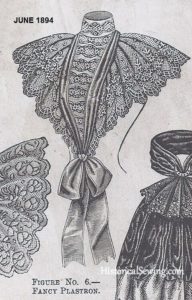
Fabrics and Trims for Plastrons
- Satin or silk with lace overlay
- Chiffon edging
- Ribbons
- Velvet
- “Spangles, jet and jeweled buckles.”
- Embroidery was also popular
Be creative with all that you can achieve with a triangle of fabric, neckband, ribbon, lace and beads!
Have you made a plastron for a 1890s ensemble? How did it enhance your outfit?


Very interesting indeed! I’ve been wondering how those fancy collares were attached to the bodice, your explanation just makes perfect sense! I’m defenetely making one of those pretty soon 😁
Hello,Dear i want to realize a dress for 1890s and i really cant find enough stuff for that time and I’m interested to know more about the parts of the dress, i would be so happy if you could help me a bit with it by telling me more for the parts of the dress , what kind of fabric should i use.
1890s saw all the natural fiber textiles used in daywear. (Those are wool, silk, cotton and linen.) Silks were the main textile for evening wear. The day ensemble would consist of a full skirt with matching bodice, or complementary shirtwaist (blouse) in cotton or linen or lightweight silk. Belts were common and could be separate or attached to the bottom of the bodice. The bodice could be open at the top as described in this blog post and filled in with a plastron or a shirtwaist worn under it.
I’m really motivated to make an 1890’s dress now, but first I have to finish up my 1760’s robe a la francaise. So many Ideas, so little time.
So.Many.Ideas…. yep!
I have an unrelated question/comment but I feel like it is something that others will relate too. I have been thinking a lot recently about getting the proper Victorian silhouette. The fact that hourglasses are more “Victorian” has made me feel almost as if I cannot get the proper Victorian silhouette or make a dress that looks like a fashion place without a super trim waist and large hips and bust. I don’t know if anyone else has experienced this phenomenon. I feel as if no matter what I do I will always short of making my dream dresses all because of my body type. Historical dressmaking is supposed to fun not something to cause body-shame. I see others with a really wide range of body shapes make gorgeous dresses but I feel like I can’t. Thoughts?
Perfectionism is telling you the lie that you can’t get the “proper silhouette.” You can. Women of ALL body shapes and sizes have existed throughout history – even in the Victorian Era. The thing, though, is to accept your own figure God gave you and work with it.
Shhh…. padding is the secret both now and then for the silhouette. They did it. We do it now. Undergarments like bum/hip pads and petticoats with fullness in the back work wonders. Ruffles on things add loft and shape. Corset covers with padding and ruffles add to the bust. Pads in the corset – at bust and hips – support the silhouette further.
You CAN do it! I’ve had to accept certain features of my own figure and that I won’t ever look as tall and skinny as the fashion plates I love. It’s been a long road to acceptance as well as a continue fight when my projects come out different than the ideal in my head. But you know what? Those costumes and creativity are being accomplished. I’d much rather try and fail and learn from than the years go by and those ideas still swirling in my brain wanting to come out.
I’m currently reading the book Finish by Jon Acuff. Throughout the chapters his focus is how to knock perfectionism. Don’t try to achieve perfection; rather strive for excellence. Find those projects that give you joy and not those costumes you chase “just because.” Your dream of a dress is yours. Not anyone else’s. Only you can make it happen with your unique creativity and perspective. Push through. We all have to, and we all have those thoughts of “why can’t this be right??” You can do it. 🙂
Oh, and if you haven’t already, here’s my post on Perfectionism in Historical Costuming.
Dear Jennifer,
I just found your blog and have been enjoying it very much. Then I saw your answer to Ms. Morris, and while it wasn’t addressed to me, it certainly spoke to me. It reminded me of the days in which I was confident enough to tell others that, unlike many of today’s modistes, the Victorians realized that no one attained the fashionable silhouette without giving Mother Nature a certain degree of assistance.
One thing I would truly find helpful, if you ever have time to consider the subject: a post addressing the concerns of the older woman. I imagine I’m old enough to be your mother — very possibly your grandmother — and while I’m young enough at heart, I have a real horror of seeming to try to masquerade as lamb. So much of what I see is clearly intended for the younger woman, and when I ask what changes were made by older women, I’m blithely assured that they wore exactly what younger women did.
It’s been lovely to find you were kind as well as knowledgeable and amusing.
Yours sincerely,
Thank you so much for reading and finding enjoyment, Mrs. Turney!
As for older, “mature” women, they did follow fashion silhouettes but with darker colors and those that are more flattering to their complexion (cream rather than white, for example). They also used richer fabrics. This is not to say older ladies could not wear a cotton summer dress, but that silk might be used to trim that cotton dress and elegant lace too. Accessories – especially jewelry – help make a more authentic impression.
I think the “mutton dressed as lamb” is a somewhat modern mindset as Victorian feels frilly and girly to us to begin with. So it already feels “fussy” when compared to our modern clothes. I think confidence and mindset play a good deal with how you wear Victorian clothing – even if it feels you are all trussed up for a roasting. 😉
Undergarments are very important, too, no matter the wearer’s age as this helps with the overall silhouette. And generally, as people age they hold onto the hairstyles of their youth in some respect as it feels comfortable. Hats are more reserved even with loads of feathers or flowers on them. Think of your own personality and what you are drawn to in historical fashion for a natural blending together – for an ensemble that flatters you in the best way. 🙂
Thank you so much for this! The 1890’s is my absolute favorite and I’ve always wondered what these were called! This post gave me some great ideas for my next costume!
Awesome!
Wonderful article! I also have a question for Elaine:where did you get that great hair decoration? Did you make it?
These are fabulous! Does anyone sell patterns for them? I’ve self-drafted some jabots, but the shoulder extensions on these look a little tricky!
I’ve seen original patterns (like from McCalls) for collars that have the shoulder epaulettes. So a search on ebay/Etsy/etc. may yield something you can use.
Thanks!
Thank you! I think you were ready my mind. This is my favorite era, and I have been looking for the how to’s.
I really need to make more 1890s. It’s so wonderful an era!
I have always admired plastrons but never had a clue how to actually attach them. Thank you so much, now I can actually add a plastron to my project list instead of just admiring them =)
Just what I’m looking for!